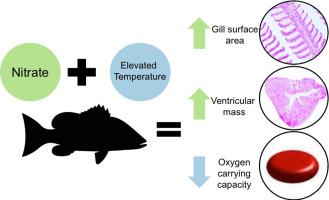Comparative Biochemistry and Physiology C: Toxicology & Pharmacology ( IF 3.9 ) Pub Date : 2020-10-24 , DOI: 10.1016/j.cbpc.2020.108920 Daniel F Gomez Isaza 1 , Rebecca L Cramp 1 , Craig E Franklin 1

|
Exposure to nitrate is toxic to aquatic animals due to the formation of methaemoglobin and a subsequent loss of blood-oxygen carrying capacity. Yet, nitrate toxicity can be modulated by other stressors in the environment, such as elevated temperatures. Acclimation to elevated temperatures has been shown to offset the negative effects of nitrate on whole animal performance in fish, but the mechanisms underlying this cross-tolerance interaction remain unclear. In this study, juvenile silver perch (Bidyanus bidyanus) were exposed to a factorial combination of temperature (28 °C or 32 °C) and nitrate concentrations (0, 50 or 100 mg NO3− L−1) treatments to test the hypothesis that thermal acclimation offsets the effects of nitrate via compensatory changes to the cardiorespiratory system (gills, ventricle and blood oxygen carrying capacity). Following 21 weeks of thermal acclimation, we found that fish acclimated to 32 °C experienced an expansion of gill surface area and an increase in ventricular thickness regardless of nitrate exposure concentration. Exposure to nitrate (both 50 and 100 mg NO3− L−1) reduced the blood oxygen carrying capacity of silver perch due to increases in methaemoglobin concentration and a right shift in oxygen-haemoglobin binding curves in fish from both thermal acclimation treatments. These results indicate that plasticity of the gills and ventricle of warm acclimated fish are potential mechanisms which may provide cross-tolerance protection to elevated nitrate concentrations despite nitrate induced reductions to oxygen transport.
中文翻译:

心肺系统的热塑性可为暴露于高硝酸盐的鱼提供交叉耐受性保护
暴露于硝酸盐对水生动物有毒,因为形成了高铁血红蛋白并随后失去了血氧的承载能力。但是,硝酸盐的毒性可以通过环境中的其他压力因素来调节,例如升高的温度。已经表明,适应高温可以抵消硝酸盐对鱼类整个动物性能的负面影响,但这种交叉耐受相互作用的潜在机制尚不清楚。在这项研究中,将少年鲈鱼(Bidyanus bidyanus)暴露于温度(28°C或32°C)和硝酸盐浓度(0、50或100 mg NO 3 - L -1)的因子组合下)处理以验证热适应通过对心肺系统的补偿性变化(g,心室和血氧携带能力)抵消硝酸盐影响的假设的治疗方法。在经过21周的热适应后,我们发现,适应硝酸盐暴露的浓度如何,适应32°C的鱼会经历g表面面积的扩大和心室厚度的增加。暴露于硝酸盐中(50和100 mg NO 3 - L -1)由于两种热驯化处理中鱼体内血红蛋白和血红蛋白浓度的增加以及氧气与血红蛋白的结合曲线的右移,降低了银鲈的血液氧携带能力。这些结果表明,温水适应的鱼的g和心室的可塑性是潜在的机制,尽管硝酸盐诱导了氧气运输的减少,但它们可能为升高的硝酸盐浓度提供交叉耐受性保护。











































 京公网安备 11010802027423号
京公网安备 11010802027423号